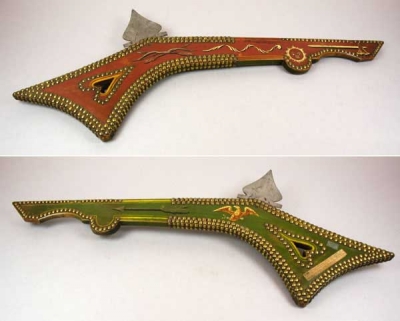Gunstock club (1886.1.818)
 USAGunstock club from the USA, Americas. Thought to have been collected by Charles A. Pope. Transferred to the Museum from the Ashmlolean Museum in 1886.
USAGunstock club from the USA, Americas. Thought to have been collected by Charles A. Pope. Transferred to the Museum from the Ashmlolean Museum in 1886.
The tomahawk was not the only club weapon used by Native Americans. This distinctive object is known as a gunstock club, so-called because of its resemblance to a musket or rifle body. Gunstock clubs were widely used across North America in the late 18th and 19th centuries, both as weapons and status symbols. They are still made and used today as part of formal dress at powwows, diplomatic events and other special occasions.
This example probably dates to around the 1820s and belonged to a member of the Osage Nation. The Osage were one of the most widespread tribes in North America, making it difficult to be sure where exactly this club came from. However, the collector, Charles Pope, was a native of St. Louis, Missouri, a region populated by the Osage, and it is likely he collected the club locally. It is decorated in brass furniture tacks and the picture shows the strikingly different red and green reverse sides, each with important and meaningful motifs.
A Place in History
Gunstock clubs were widespread, found across North America from the Southern to the Eastern Plains. Thicker and heavier types of gunstock clubs were used in the Northern Plains, while the Sioux in the Midwest used longer and slimmer versions.
This club is interesting historically due to both its form and its decoration. The shape was no accident but rather the result of indigenous peoples to imitate the firearm weapons that the Europeans brought across the Atlantic with them from the 16th and 17th centuries. In another nod to European weaponry, the heart-shaped blade on the top edge is a representation of a 'spontoon', a rather ornate European polearm that gained popularity after the mid-17th century and was one of the few polearms to remain in use long enough to gain a place in American history. In terms of decoration, this club also displays some European influences in its use of brass furniture tacks. These were acquired from white settlers and like the Osage, the Sioux and Blackfoot (Niitsítapi) also used them to ornament their knife sheaths.
It is possible that this club may be a tourist item due to its bold colours and large painted motifs. Nonetheless, these motifs are important as they have a historical basis as meaningful symbols. On the red side, the gold pipe tomahawk, the bow and arrows, and the sun face suggest tribal warfare and the Northern Plains Sun Dance, a major ceremony observed across much of the region. On the other side is painted an arrow and an eagle. Raptorial birds were powerful symbols among many Native tribes (hawks in particular were important to the Osage as symbols of warfare). Surprisingly however, this is not a Thunderbird of Native spirituality but the American Eagle of the Great Seal of the United States. We can tell this because it carries a laurel branch in its talons. This motif is seen every dollar bill and is usually surrounded by a banner reading 'E Pluribus Unum', meaning, 'One Out of Many'. Several Native American tribes adopted the American Eagle because it was a new symbol of power and authority, yet also linked to older tribal ideas about powerful Thunderbirds. Native Americans sometimes used it as a symbol of allegiance after signing treaties with the United States Government and this suggests the club may have been used as a diplomatic object. Which side of this club might have been faced outwards by its Osage owner - that exhibiting the symbols of traditional Plains life or that expressing a diplomatic and accepting attitude to the white settlers - depended very much on the statement he wanted to make to his viewers.





